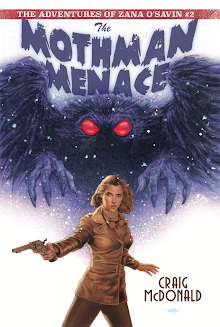The following is an essay written in 2010 for the hardcover edition's release that originally appeared in Mystery Scene Magazine.
__________________
Ernest Hemingway wrote, "All stories, if continued far enough, end in death." It's possible Hemingway's 1961 death by shotgun blast was something other than the suicide history records.
My new novel, Print the Legend, explores Hemingway’s
demise: one of the most infamous of American authors’ deaths. Given its violent
circumstances, it may also be the most unjustly under-investigated.
If Papa’s fourth wife, Mary
Welsh, had actually set out to cast suspicion upon herself in relation to her
famous husband’s death, she could hardly have done a better job.
When Ernest’s apparent
self-destructive impulses first manifested themselves, Mary took some efforts
to protect Hemingway from himself.
But on his first night back
from his last round of electroshock treatments administered at the Mayo Clinic
— shock treatments approved by Mary for a man who had sustained innumerable
concussions and therefore was not a prospect for such radical treatment — Mary
reversed course.
Mary locked away her
husband’s extensive cache of guns. But she left the key to their hiding place
on a shelf above the kitchen sink. She left them there in plain sight the night
of July 1, 1961 — the eve of her widowhood.
When confronted about
virtually handing her husband the means to kill himself, Mary argued nobody had
a right to deprive a man “his possessions.”
Papa’s last wife was alone
with her husband in their Ketchum, Idaho home that bloody morning.
By her own account, Mary didn’t immediately respond to the sound of the twin shotgun blasts — despite the fact the fatal shots were fired directly under her bedroom.
She had vaguely heard, she
said, what sounded like “drawers slamming shut.” She claimed to find the
carnage later in the morning.
Within a few hours of
Ernest’s death, Mary was working the phones — calling friends and
family…syndicated columnists. She was engaging in deft spin-doctoring decades
before the term was invented.
One of those who received one of the strange, morning-of calls from the newly minted widow was Hemingway friend, William Walton. Many years after that bloody July morning, when confronted by scholar Rose Marie Burwell’s suspicion that Mary wanted her husband dead, Walton confided, “Now that you’ve said it, I will say what I have never said before, but have known since Mary called a few hours after Ernest’s death: yes, she did.”
One of those who received one of the strange, morning-of calls from the newly minted widow was Hemingway friend, William Walton. Many years after that bloody July morning, when confronted by scholar Rose Marie Burwell’s suspicion that Mary wanted her husband dead, Walton confided, “Now that you’ve said it, I will say what I have never said before, but have known since Mary called a few hours after Ernest’s death: yes, she did.”
Mary claimed Papa’s death was
a gun-cleaning accident. The physician of record advanced that story, though he
also noted there was no evidence of gun-cleaning materials found at the death
scene.
The widow Hemingway was also
an active participant in an ad hoc
committee to determine whether there should be an inquest. Mary carried the day
— no official inquiry was made.
Family cleaned up the death
scene; the shotgun was destroyed — either by a family friend, or the Hemingway
sons — accounts vary.
In the wake of Ernest’s
death, Mary became Papa’s literary executrix — revising his manuscripts,
re-titling his books…designing his dust jackets and reaping huge financial
rewards.
Did Mary murder Hemingway?
Could, perhaps, she have
played some other role in his passing?
In Print the Legend, I supply my own theory regarding Hemingway’s
death — something other than the one that history records.












































No comments:
Post a Comment